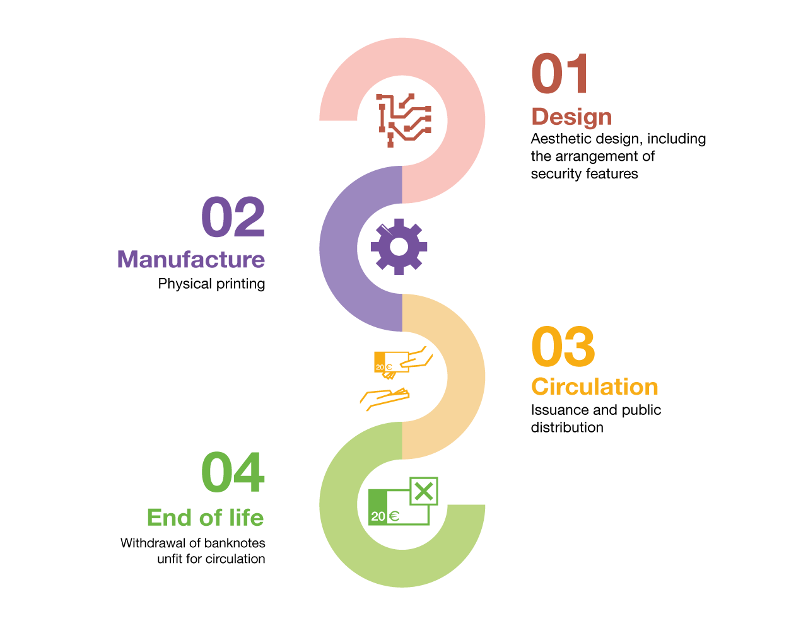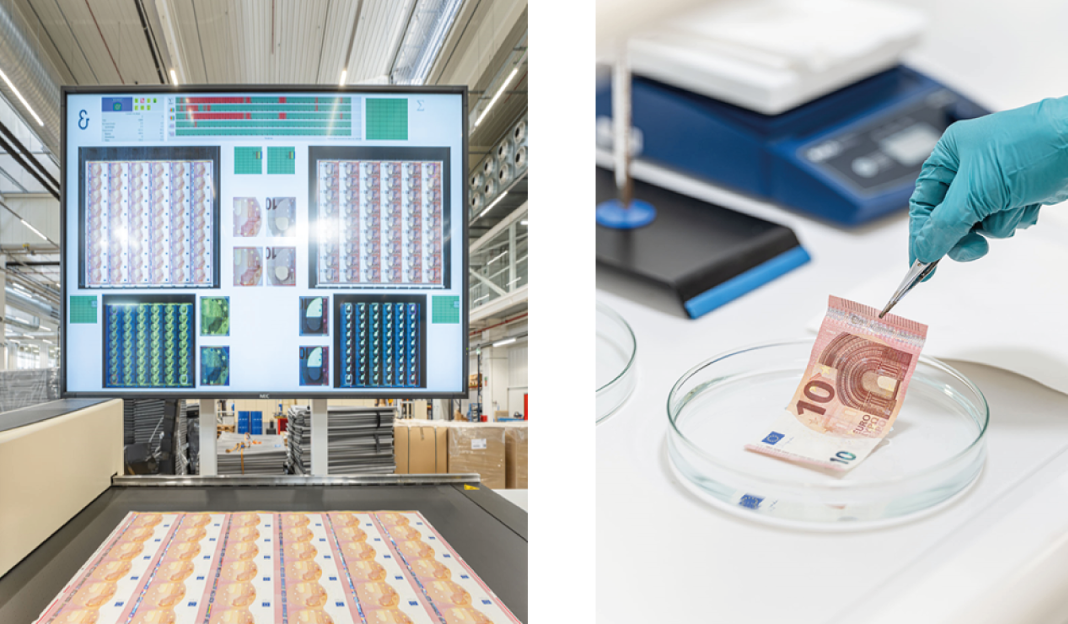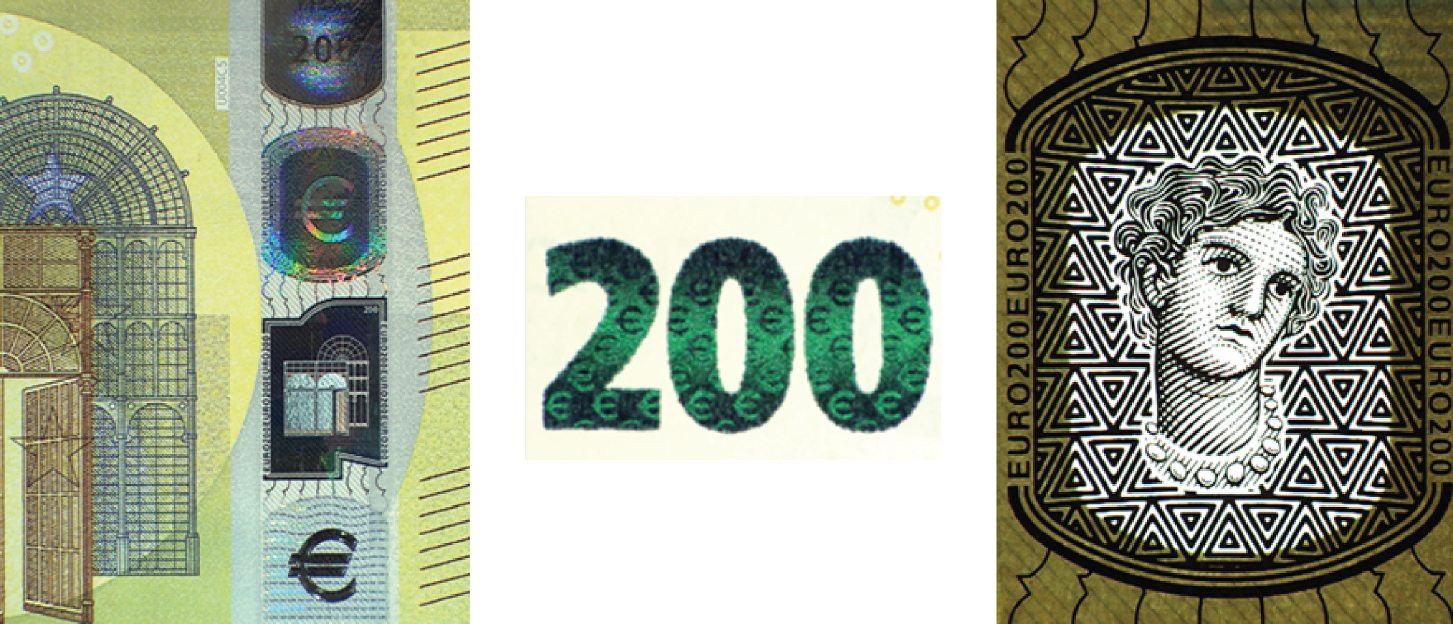Traditional, but indispensable and cutting-edge. How much tech is packed into a banknote?
Cash is still essential in the digital age. Banknotes – from their design to production – incorporate the latest technology to be more secure, durable and sustainable. They are high-tech industrial products that are constantly being enhanced. At the Banco de España, we help design the banknotes of the future.
12/05/2025
The recent blackout showed that cash and banknotes are still indispensable. These traditional means of payment are, at the same time, true marvels at the cutting edge of technology. The technology used in the design, production, public circulation and recycling of euro banknotes makes them durable, sustainable and extremely secure. What advanced technologies lie behind each banknote?
Banknotes use colours and textures to be easily recognisable by everyone, especially those with visual impairment. Additionally, they incorporate advanced security features, such as laser-etched holograms, colour changes with special inks, raised print that can be felt and infrared and ultraviolet properties that allow them to be used in automated systems. They are made of materials with special physical and chemical properties that make them resistant to water, heat and other external agents, which helps make them durable and difficult to counterfeit.
The technology in the design, production, and recycling of euro banknotes makes them durable, sustainable, and extremely secure, as well as appealing and user-friendly
The technology behind every stage of a euro banknote's life cycle (Figure 1) is comparable to that of other industrial products, such as cars or computers, and it is this technology that makes banknotes a secure, efficient means of payment suited to the modern needs of our society.
Figure 1
LIFE CYCLE OF BANKNOTES ISSUED BY THE BANCO DE ESPAÑA

SOURCE: Banco de España.
Turning to the design, the Banco de España and the Universitat Politècnica de València have developed the Neurocash®![]() methodology (Image 1), which employs the latest in neuroscience and artificial intelligence technologies to measure human behaviour and analyse reactions, visual attention, tactile perception, and, ultimately, how people interact with cash. We can use Neurocash® to understand the public's perception of cash in an objective and scientific way: not only their conscious responses but also their unconscious ones, which are more reliable when it comes to understanding preferences. This methodology will help make future banknotes more appealing and secure, with a simple and easy-to-use design.
methodology (Image 1), which employs the latest in neuroscience and artificial intelligence technologies to measure human behaviour and analyse reactions, visual attention, tactile perception, and, ultimately, how people interact with cash. We can use Neurocash® to understand the public's perception of cash in an objective and scientific way: not only their conscious responses but also their unconscious ones, which are more reliable when it comes to understanding preferences. This methodology will help make future banknotes more appealing and secure, with a simple and easy-to-use design.
Did you know...?
In the Cash Department of the Banco de España, we seek out scientific and technological innovations that can be applied to future euro banknotes![]() with funding from the European Central Bank.
with funding from the European Central Bank.
If you have any innovative ideas, get in touch at investigacionydesarrollo.billetes@bde.es. ![]()
Image 1
CASH DESIGN: THE NEUROCASH METHODOLOGY

SOURCE: Banco de España.
NOTE: Neurocash® is based on a patent developed by the Cash Department of the Banco de España.
We use eco-friendly design to help reduce the environmental impact of banknotes, using the greenest energy (from renewable natural sources that have a low environmental footprint) throughout the cash cycle and the most sustainable raw materials and processes. All raw materials comply with European health and safety regulations. And we incorporate one of the key principles of the circular economy by using a waste by-product of another sector as a raw material: banknotes are made from cotton not fit for the textile industry.
As for banknote production![]() , the digital era has brought progress in the way banknotes are printed, both in the manufacture of press plates and in the printing machines themselves (Image 2). In general, the production process has been automated, thus reducing manual handling and making it safer for operators and increasing banknote security.
, the digital era has brought progress in the way banknotes are printed, both in the manufacture of press plates and in the printing machines themselves (Image 2). In general, the production process has been automated, thus reducing manual handling and making it safer for operators and increasing banknote security.
Image 2
TECHNOLOGY USED IN BANKNOTE PRODUCTION

SOURCE: Banco de España.
The final quality control tests in the production process simulate everyday situations, such as extreme heat, folding, accidental washing and ironing, or sweaty clothing, to make banknotes that are resistant and durable.
The printing machines also incorporate various in-line and end-of-line quality controls to ensure security and durability. Data analysis and troubleshooting are done almost immediately.
Thanks to digital technology, we can use our banknotes in machines, without the need for human intervention
Thanks to the digital revolution, we can use our banknotes, for example, in vending machines and parking meters, which identify and authenticate them without the need for human intervention.
As for security measures, euro banknote features are constantly being enhanced by incorporating breakthroughs in technology and security, making them more difficult to counterfeit. These features can be checked by machines and devices, and can be easily recognised by the public using the “feel, look, tilt” method![]() . For example
. For example![]() (Image 3):
(Image 3):
- The window in the hologram, created using laser technology, displays changing colours and images when tilted. When held against the light, the €20, €50, €100 and €200 banknotes of the Europa series reveal a transparent window with a portrait of the mythological Princess Europa.
- The emerald green number, showing the banknote’s value, displays a shifting change in colour. Through special ink pigments, it produces a metallic sheen that shifts vertically, and when the banknote is tilted, it changes from emerald green to deep blue.
Image 3
TECHNOLOGY USED IN BANKNOTE SECURITY

SOURCE: Banco de España.
For banknotes at the end of their lifespan and unfit for circulation, recycling alternatives are sought to reduce their environmental impact. We use such banknotes for energy recovery by incinerating them.
What is the environmental footprint of euro banknotes? In an earlier blog post, we pointed out that our banknotes are "green"![]() . There we discussed the ECB study
. There we discussed the ECB study![]() , conducted in collaboration with the Eurosystem national central banks, which concludes that the environmental footprint of an average European citizen paying for their usual purchases with euro banknotes for a whole year is very low, equivalent to driving 8 km by car.
, conducted in collaboration with the Eurosystem national central banks, which concludes that the environmental footprint of an average European citizen paying for their usual purchases with euro banknotes for a whole year is very low, equivalent to driving 8 km by car.
In short, the life cycle of the euro banknote is constantly evolving and improving thanks to current technological innovations. These improvements have one goal: to create a banknote that is increasingly appealing, secure, durable and sustainable, so that this traditional yet essential means of payment can continue to be used with full guarantees.
DISCLAIMER: The views expressed in this blog post are those of the author(s) and do not necessarily coincide with those of the Banco de España or the Eurosystem.




